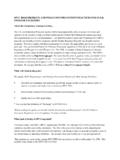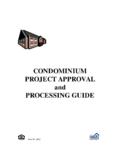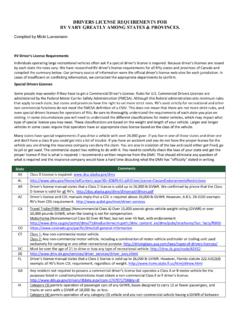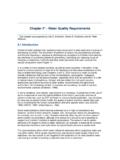Transcription of USCG Minimum Equipment Requirements for …
1 USCG Minimum Equipment Requirements for recreational Vessels 2010 Edit ion Boat Length in Feet Less than 16', canoes, kayaks 16' to 26' (8m) 26' to ' (12m) 40' to 65' 65' to 165' (50m) Personal Flotation Devices One Type I, II, III, or V per person. PFD's must be CG Approved, wearable by the intended user and readily accessible One Type I, II, II, or V per person plus one Type IV throw able device. PFD's must be CG Approved, wearable by the intended user and readily accessible. The Type IV throw able device must be located such that it is immediately available. Fire Extinguishers No fixed system One B-I any type. Fire extinguishers required on any boat with enclosed fuel or engine spaces, enclosed living spaces, or permanent (not movable by one person) fuel tanks. One B-II or two B-I One B-II and one B-1 or three B-1 One to eight B-II (Depends on weight) Plus additional Requirements in machinery space - for detail specifics see With fixed system No portables required One B-I Two B-I or one B-II Visual Distress Signals on Coastal Waters Night signals required when operating between sunset and sunrise.
2 Minimum of three day-use and three night-use or three day/night combination pyrotechnic devices. Non-pyrotechnic substitutes: 1 orange flag (day-use) and 1 electric S-O-S signal light (night-use) Sound Producing Devices Horn or whistle recommended to signal intentions or position. Under Rule 33 of the Navigation Rules, boats under 20m MUST have aboard a means of making an efficient sound. Bell no longer required by Federal Regulations One bell not less than 300mm for boats larger than 20m and one whistle or horn required to signal intentions or position. Backfire Flame Arrestors One CG-Approved device on each carburetor of all gasoline-powered engines built after April 1940, except outboards. Arrestor should be kept clean to prevent contamination from propagating a flame. Ventilation CG-standard powered system required on gasoline-powered vessels with enclosed engine spaces built after 1 August 1980.
3 Boats built earlier must have either natural or powered ventilation in the fuel tank compartment. Navigation Lights Under power Sidelights, stern light, masthead light. Boats 16' or longer must also have an 360 all-around white anchor light capable of being lit independently from the red/green/white running lights. Sailboats under power are considered powerboats and must follow "under power" rules. Under sail Sidelights and stern light. Boats under sail under 20m ( feet) can substitute a tri-color light for separate sidelights and stern lights. Sailboats under power are considered powerboats and must follow "under power" rules. Rowing Sailboats and powerboats under 7m and under 7 knots can substitute a white lantern in place of the required lights. At Anchor All around white light visible for 2nm at night unless in a chart-designated anchorage. Visibility range 1 nm side lights, 2 nm all others 3nm masthead, 2 nm all others 5nm masthead, 2nm all others Pollution Regulations "Honor system", no plaques required.
4 5" X 8" Oil Discharge placard and 4" X 9" MARPOL Trash placards. Vessels over ' with a galley must have a Waste Management Plan. Marine Sanitation Devices Vessels with installed head facilities must have an operable CG-Certified Type I, II, or III Marine Sanitation Device (MSD). Any "Y" value for discharge overboard must be located in such a manner or affixed to prevent accidental discharge of untreated waste into water. Type II or III MSD only. Navigation Rules Familiarity with the rules is recommended but not required. Boaters should be familiar with the "Rules of the Road" for crossing and overtaking situations, as well as meeting other vessels head on. Vessels 12m ( ') or over are required to have a current copy of the USDOT USCG International - Inland Navigation Rules aboard.





